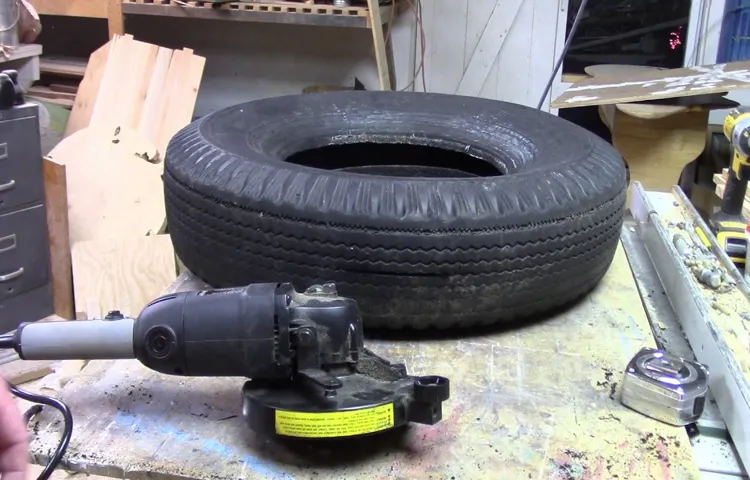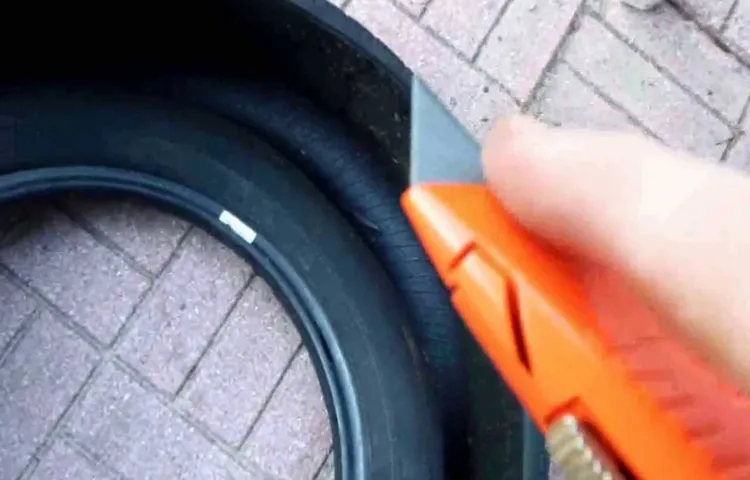Are you looking for a fun DIY project that also repurposes an old tractor tire? Cutting a tire in half can be a great way to create unique garden planters or even exercise equipment. But how do you cut through the tough and thick rubber of a tractor tire without causing damage to your tools or injuring yourself? In this article, we will explore the steps and tools needed to successfully cut a tractor tire in half, as well as some safety tips to keep in mind throughout the process. So grab your safety goggles and let’s get started!
Table of Contents
Safety Precautions
Cutting a tractor tire in half may seem like a daunting task, but it can be done with the right tools and precautions. First and foremost, it’s important to wear protective gear such as work gloves, eye protection, and sturdy footwear. To start, make sure the tire is completely deflated and place it on a flat, sturdy surface.
Using a power saw with a diamond blade, slowly and carefully cut through the tire in a straight line. It’s important to remember to not force the saw through the tire, as this can cause the blade to bind and kick back. Take breaks if necessary to prevent the saw from overheating.
Once the tire is cut in half, properly dispose of the scraps and clean up any debris. By following these safety precautions, cutting a tractor tire in half can be done safely and efficiently.
Eye and ear protection
Eye and ear protection are crucial safety precautions to take in various tasks and industries. Eye injuries can range from minor irritations to severe trauma resulting in permanent vision loss, especially when working with hazardous chemicals or machinery. Wearing protective eyewear such as goggles or safety glasses can significantly reduce the risk of eye injuries.
Similarly, exposure to loud noises without ear protection can cause temporary or permanent hearing damage. This is common in industries like construction or music production where noise levels can exceed the safe threshold. The use of earplugs or earmuffs is essential to prevent hearing loss.
When performing tasks that require both eye and ear protection, it’s best to use equipment that combines both to ensure maximum safety. Remember, protecting your eyes and ears is not only necessary but also cost-effective in the long run compared to medical bills resulting from injuries.

Gloves and work boots
When it comes to workplace safety, gloves and work boots are two essential gear items that cannot be overlooked. Both of these items are designed to protect workers from various types of injuries and hazards. Work gloves can provide protection against cuts, abrasions, and punctures from sharp objects, while work boots can protect workers’ feet from falling objects, slips, and electrical hazards.
It’s important to wear gloves and work boots that are appropriate for the work environment, such as insulated boots for cold weather or chemical-resistant gloves for handling hazardous materials. By wearing gloves and work boots, workers can significantly reduce their risk of injuries and improve their overall safety on the job. So, make sure to invest in high-quality gloves and work boots that are designed to meet safety standards and provide maximum protection.
Your hands and feet will thank you for it!
Ensure proper ventilation
When it comes to maintaining safety in any space, ensuring that there is proper ventilation is crucial. Whether it’s in a home or workplace, inadequate ventilation can lead to a buildup of harmful chemicals and pollutants in the air, which can be dangerous for anyone in the space. One way to ensure proper ventilation is to regularly open windows or doors to let fresh air in and allow stale air to escape.
Some spaces may require additional measures, such as the installation of exhaust fans or air purifiers. It’s also important to keep an eye on the humidity levels, as high levels can lead to the growth of mold and mildew, which can also be harmful to health. By taking these measures, you can ensure that the air in your space is clean and safe to breathe, promoting the health and well-being of everyone who spends time there.
Materials Needed
Cutting a tractor tire in half may seem like a daunting task, but with the right tools and materials, it can be done easily. First off, you will need a jigsaw, reciprocating saw or a circular saw with a very powerful blade. You’ll also need a sturdy workbench or sawhorses to support the tire while you make the cut.
Additionally, you’ll need a measuring tape and a marker to mark the line where you want to cut. A pair of safety goggles and gloves are important to protect yourself from flying debris and sharp edges, so don’t forget them. Finally, if you plan on using the halved tire for a project, make sure to have a trash can or large bag to dispose of the unwanted half.
With all of these materials, you’ll be ready to start the process of cutting a tractor tire in half like a pro!
Circular saw with a diamond blade
Circular saw with a diamond blade is a powerful tool that renders precise cuts and a smooth finish on hard materials such as concrete and stone. Depending on the job that needs to be done, there are a few materials required to operate the saw. Firstly, you need to get an appropriate diamond blade, sufficient for the material that needs cutting.
You may opt to purchase the blade separately or as part of the package, which includes everything needed for the job. Besides, a source of power, an extension cable and a source of water are required. If you’re going to cut concrete or any other material, you must keep the blade cooled with water since cutting produces dust and generates heat, affecting the performance and durability of the blade.
The circular saw with a diamond blade is a flexible tool, adaptable to different cutting needs. With appropriate care and maintenance, it can last for years and deliver quality results every time it’s used.
Ruler or measuring tape
When it comes to measuring objects accurately, having the right tools for the job is crucial. One such tool is a ruler or measuring tape, which can help you get precise measurements of just about anything. To use these tools effectively, you’ll need to have a few materials on hand.
First and foremost, you’ll need a ruler or measuring tape (or both). Rulers are typically made of metal or plastic and are often marked in both centimeters and inches, making them versatile and easy to use. Measuring tapes, on the other hand, are often made of flexible materials like cloth or plastic, and can be measured in feet, inches, or both.
Other materials that can come in handy when using a ruler or measuring tape include a pencil or pen to mark your measurements and a level to ensure that your measurements are accurate. With these materials in hand, you’ll be well on your way to precision measuring.
Chalk or marker
When it comes to creating visuals or presentations, choosing the right writing tool can make a big difference. Two popular choices are chalk and markers, each with their own unique benefits. For chalk, you’ll need a chalkboard or chalkboard paint, as well as a set of chalk sticks.
Chalk provides a classic feel and can be easily erased, making it great for brainstorming and working through ideas. On the other hand, markers offer a wider range of color options and can be used on a variety of surfaces such as whiteboards, glass, or even paper. They also tend to produce crisper lines and are better for creating more polished final products.
Ultimately, the choice between chalk or markers depends on what kind of project you’re working on, your personal preference, and the available materials at your disposal. Regardless of which tool you choose, keep in mind that both offer endless creative possibilities and can help bring your ideas to life.
Clamps or vise grips
Clamps or vise grips are essential tools for every handyman or DIY enthusiast. If you’re planning a construction or renovation project, you will surely need clamps or vise grips to hold pieces of wood, metal, or plastic in place. These tools come in different sizes, shapes, and types, so you can choose the ones that match your needs and preferences.
The materials needed to use clamps or vise grips depend on the type and size you have. Generally, you need to have a set of pliers or wrenches to tighten or loosen the clamps, a sturdy workbench, and protective gear like gloves and goggles. Some clamps or vise grips may require additional accessories like pads or plates to avoid damaging the workpiece or to provide a better grip.
When choosing clamps or vise grips, consider the weight capacity, the opening size, the throat depth, and the grip force. These factors will determine whether the tools can handle your project’s requirements and prevent accidents or injuries. In summary, clamps or vise grips are versatile and reliable tools that every DIY enthusiast should have.
You don’t need to spend a fortune to get the best ones, but make sure you invest in quality and durability to use them for a long time.
Cutting the Tire
If you’re looking for a fun and unique DIY project, cutting a tractor tire in half might be just the thing for you. First, you’ll need a few tools – a reciprocating saw with a metal blade, a drill with a large bit, and possibly a sledgehammer. Start by drilling a hole in the sidewall of the tire, making sure it’s toward the treads and not the center of the tire.
Then use the saw to cut through the rubber from the hole to the opposite sidewall. You may need to use the sledgehammer to help break through any thick steel cords or inner linings inside the tire. Once you’ve cut all the way through, you should be left with two halves of a tire.
You can use these halves for a variety of projects, from planters to outdoor seating. Just keep in mind that cutting a tire can be challenging and requires caution, so be sure to take safety precautions and wear protective gear. With a little patience and care, you can create something truly unique and eye-catching using just an old tractor tire.
Mark the cutting line with chalk or marker
Cutting a tire can be a challenging task, but with the right tools and techniques, it can be accomplished with ease. Once you have identified the area of the tire that needs to be cut, the next step is to mark the cutting line with either chalk or a marker. This will give you a clear visual guide as to where you need to make your cuts, and will also help you to ensure that your cuts are straight and even.
When marking the cutting line, it is important to take your time and be as precise as possible. After all, any mistakes you make at this stage could compromise the final result and potentially render the tire unusable. Therefore, it’s a good idea to double-check your markings before proceeding to the next step.
Once you’re satisfied that you have marked the cutting line correctly, it’s time to move on to the actual cutting process. With the right approach, cutting a tire can be a manageable task that yields great results.
Apply clamps or vise grips to hold the tire in place
Applying clamps or vise grips to hold the tire in place is essential before cutting into it for any repair work. This step is crucial as it ensures that the tire remains stable and secure while being worked on, preventing any slips or accidents. It is essential to use sturdy and grip-friendly clamps or vise grips that can hold the tire firmly without damaging it.
Before cutting the tire, it is also critical to ensure that the area around it is clean and free from debris that could interfere with the cutting process. When cutting the tire, it is vital to use a sharp and durable blade, such as a sharp utility knife or a tire cutting machine, to ensure smooth and precise cuts. Remember to take all necessary safety precautions when working with tools to prevent any injuries or accidents.
Overall, applying clamps or vise grips is a critical step before cutting into the tire, and it should never be overlooked.
Use the circular saw to cut along the marked line
When it comes to cutting a tire, a circular saw is a must-have tool. Once you’ve marked the line where you want to cut, it’s time to fire up the saw and begin cutting. Begin by positioning the blade of the saw right on the line and slowly move the saw forward.
Keep your hands and feet away from the blade at all times. It’s important to maintain a steady pace while cutting to ensure a smooth, clean cut. As you cut, the blade will generate heat, so make sure to pause intermittently to give it time to cool down.
Once you reach the end of the line, turn off the saw and let it come to a complete stop before removing the tire from the work surface. Cutting a tire can be a challenging task, but with the right tools and techniques, it can be done easily and safely. So, go ahead and give it a try – you might just surprise yourself with the results!
Take breaks to cool the blade if needed
Cutting a tire is no easy task, especially if you don’t have the right tools. However, if you know how to use a reciprocating saw, you can easily cut through a tire. First, make sure you have a blade that is specifically designed for cutting rubber.
Then, mark the tire where you want to make your cut. Be sure to wear safety goggles and gloves to protect yourself from flying debris. As you start cutting, you may notice that the blade heats up quickly.
If this happens, take breaks to cool the blade if needed. Keep in mind that cutting through a tire can take some time, so don’t rush the process. Take your time and let the saw do the work for you.
With a steady hand and a bit of patience, you’ll have that tire cut in no time.
Disposing of the Tire
Once you’ve cut your tractor tire in half, you might be wondering what to do with the halves. Don’t worry – there are plenty of options! One popular choice is to use the halves as planters for your garden. You can fill them with soil and grow flowers, vegetables, or herbs.
Another option is to turn them into outdoor seating. Simply place the halves flat on the ground and add a cushion on top for a unique and rustic look. If you don’t need the halves for anything and want to dispose of them, make sure to check with your local recycling center to see if they accept tires.
Many centers have facilities that can properly dispose of them, so you can at least feel good about your eco-friendly choice. Overall, cutting a tractor tire in half can provide endless possibilities for creative and unique projects both inside and outside the home.
Check local regulations for safe disposal methods
When it comes to disposing of tires, it’s important to keep in mind that local regulations play a big role in determining the safe methods of disposal. In many areas, simply throwing old tires in the trash bin is not allowed due to environmental concerns. Instead, there may be specific recycling centers or collection points where you can drop off your used tires for proper disposal.
Some areas even have companies that specialize in tire recycling and will pick up your old tires for a fee. It’s important to research and follow the guidelines set forth by your local government to ensure that you are not only disposing of your tires in a safe and responsible manner, but also avoiding any potential fines or penalties. By taking the time to properly dispose of your old tires, you can help protect the environment and keep your community safe.
Take the tire to a recycling center if possible
When it comes to disposing of tires, it’s important to be mindful of the impact they can have on the environment. One option for responsible disposal is to take the tire to a recycling center if possible. Many centers specialize in the recycling and repurposing of old tires, turning them into new products such as playground surfaces, mulch, and even fuel.
Recycling tires not only prevents them from taking up space in landfills but also reduces the need for new resources to be extracted and processed. So next time you’re replacing a tire, consider taking it to a recycling center instead of simply throwing it away. By doing so, you can do your part to help preserve our planet for future generations.
If not, cut the tire into smaller pieces for easier disposal
If you find yourself needing to dispose of a tire, it’s important to do so properly to avoid any negative impact on the environment. First, check if there are any tire recycling facilities in your area. These facilities can recycle tires into new products, reducing the amount of waste that ends up in landfills.
If recycling isn’t an option, consider repurposing the tire. For example, tires can be used as garden planters or swings for children. If neither recycling nor repurposing are viable options, you can cut the tire into smaller pieces.
This will make it easier to dispose of and prevent it from taking up too much space in a landfill. Remember to always dispose of tires responsibly to help minimize their negative impact on the environment.
Conclusion
Cutting a tractor tire in half is no easy task, but with the right tools and technique, anyone can do it. Just be sure to take the necessary safety precautions, like wearing eye protection and using a sturdy saw blade. And remember, once you’ve successfully cut that tire in half, you now have two halves of a tire – perfect for creating outdoor seating, planters, or even a unique coffee table.
So get creative and give that old tire a new life!”
FAQs
What type of saw blade should I use to cut a tractor tire in half?
It’s best to use a blade specifically designed for cutting through rubber, such as a tungsten carbide coated blade.
Can I use a regular circular saw to cut a tractor tire in half?
While it’s possible to use a circular saw, you may run into issues with the blade becoming dull quickly or getting stuck in the rubber. It’s not recommended.
What safety precautions should I take when cutting a tractor tire in half?
Wear eye and ear protection, as well as gloves and a dust mask to avoid inhaling rubber particles. Make sure the tire is securely held in place and use a stable cutting surface.
Do I need any special equipment to cut a tractor tire in half?
Some type of saw will be necessary, as well as a blade suitable for cutting rubber. A sturdy work surface and clamps or other means of holding the tire in place is also recommended.
Will I need to make multiple passes to completely cut through the tire?
Depending on the thickness and density of the tire, it’s possible that multiple passes with the saw will be necessary to achieve a clean cut. Be patient and take your time to avoid damaging the blade or the tire.
Can cutting a tractor tire in half be done by one person, or would assistance be needed?
It’s possible for one person to cut a tractor tire in half, but having another person to help hold the tire steady may make the task easier and safer.
What are some practical applications for using a cut tractor tire?
Cut tractor tires can be repurposed in a variety of ways, such as using them as planters, weightlifting equipment, garden beds, or even as a base for a DIY outdoor seating area.



